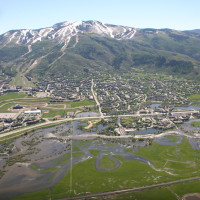The following article was published by the Steamboat Pilot & Today by Tom Ross on March 9th 2017. Full article with photos can be seen here: http://www.steamboattoday.com/news/2017/mar/09/abundant-snowpack-doesnt-always-fill-area-reservoi/
Steamboat Springs — The amount of water currently stored in two critical reservoirs on the upper Yampa River south of Steamboat Springs appears better than average, but water managers here aren’t taking anything for granted.
When Denver-based federal Snow Survey Supervisor Brian Domonkos, of the Natural Resources Conservation Service, released his March 1 water forecast, he noted that the water in the snowpack of the Yampa Basin was 115 percent of median for the date. And, the water currently stored in Stagecoach Reservoir, just east of Oak Creek, and in Yamcolo Reservoir, on the edge of the Flat Tops south of Yampa, is more than 120 percent of average.
But Kevin McBride, general manager of the Upper Yampa Water Conservancy, which owns the two reservoirs, said March 9 his office is looking at the snowpack on a weekly basis — and sometimes, on a daily basis, this time of year — and tweaking how much water it is releasing from Stagecoach. It’s all about balancing releases of water with the projected inflow of melting snow in order to get to the finish line with a reservoir that’s full, but not too full.
“It’s hard to outthink the weather, but so far, it look pretty good,” McBride said March 9. “We’re making full (hydroelectric) power right now at Stagecoach and bringing it down a little bit. It’s carbon-neutral power, and we’d like to make as much as we can.”
McBride said he’s less interested in reports of average reservoir storage, because those numbers can be skewed by either record low or record high years. He and District Engineer Andy Rossi meet with the dam managers every Monday to strategize.
With the reservoir level at Stagecoach almost 125 percent of average going into the second week of March, one might think dam managers have it made. But McBride doesn’t take anything for granted. After heavy snowfall in both December and January, the upper Yampa Valley has seen meager snow in February, continuing through the first week in March. Spring snowmelt can peak suddenly, catching dam operators by surprise, and summer precipitation could falter, causing the level of the reservoir to slip as irrigators seek to flood their hayfields.”
“On March 1, we start tracking the river and every drop that goes in or out of Stagecoach,” McBride said. It’s also “the beginning of our administrative year for water rights.”
Upper Yampa keeps close track of the same snow-measuring sites (referred to as snotels) the Conservation Service manages but customizes the data for its needs. Bullish snowpack measurements in early March don’t necessarily convert to a smooth runoff for dam managers. McBride observed that, while the snotels at higher elevations are reflecting above average snowpack, “town looks kind of dry.” That leads him to wonder if low elevation runoff might occur earlier than usual this season, affecting inflow at the dam later in spring.
“Last year, we had pretty good snowpack, but the (July/August) monsoons weren’t very good,” McBride said. “We want to be 90 percent sure we’re going to fill.”
On the other hand, McBride said, the ideal scenario would be if the snowpack that feeds Stagecoach came off “nice and slow, and we can control it.”
McBride hopes against a heavy rain-on-snow event that could bring the snowpack off faster than dam managers can keep up with. Were that to happen while ice still covers the reservoir, there’s a chance chunks of ice could be washed over the spillway and potentially cause damage.
Time will tell how the spring runoff of 2017 will unfold.
To reach Tom Ross, call 970-871-4205, email tross@SteamboatToday.com or follow him on Twitter @ThomasSRoss1
